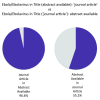Publications in PubMed on Ebola and the 2014 outbreak
- PMID: 26539291
- PMCID: PMC4629280
- DOI: 10.12688/f1000research.6206.2
Publications in PubMed on Ebola and the 2014 outbreak
Abstract
In this research note we examine the biomedical publication output about Ebola in 2014. We show that the volume of publications has dramatically increased in the past year. In 2014 there have been over 888 publications with 'ebola' or 'ebolavirus' in the title, approximately 13 times the volume of publication of 2013. The rise reflects an impressive growth starting in the month of August, concomitant with or following the surge in infections, deaths and coverage in news and social media. Though non-research articles have been the major contributors to this growth, there has been a substantial increase in original research articles too, including many papers of basic science. The United States has been the country with the highest number of research articles, followed by Canada and the United Kingdom. We present a comprehensive set of charts and facts that, by describing the volumes and nature of publications in 2014, show how the scientific community has responded to the Ebola outbreak and how it might respond to future similar global threats and media events. This information will assist scholars and policymakers in their efforts to improve scientific research policies with the goal of maximizing both public health and knowledge advancement.
Keywords: Ebola; Pubmed; publications.
Conflict of interest statement
Figures





































References
LinkOut - more resources
Full Text Sources
Other Literature Sources
Miscellaneous

